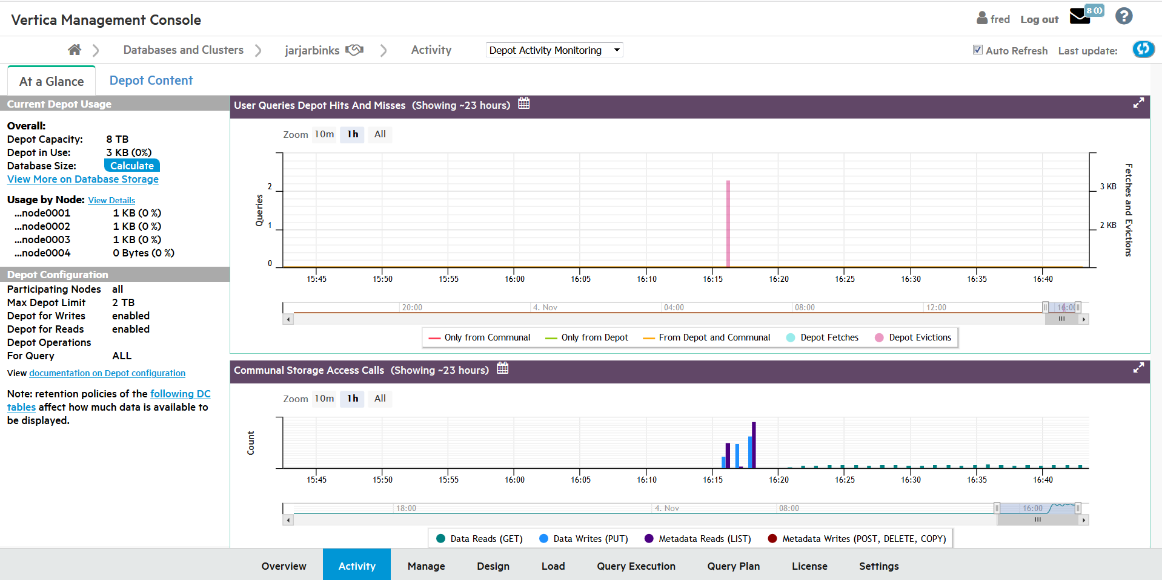Monitoring Depot Activity in MC
If your database is in Eon Mode, you can use the Depot Activity page to monitor query activity, churn, and settings for your database's depot. The depot (see Eon Mode Architecture) is a cache-like component on each node that improves query performance by preventing your queries from having to go to communal storage every time. Instead the queries access the depot, which contains local copies of your data.
To view the Depot Activity page, select the Activity tab at the bottom of your database's Overview page, then select Depot Activity Monitoring from the chart list. The Depot Activity page has two tabs:
- At a Glance: The default, described below
- Depot Content: Described in Monitoring Depot Content in MC)
The Depot Activity Monitoring page is not available when the database is in Enterprise Mode. See Using Eon Mode for more about Vertica database modes.
At a Glance Tab
The At a Glance tab has three sections:
- Current Depot Usage and Depot Configuration (left pane)
- User Queries Depot Hits and Misses, Fetches and Evictions (upper-right pane)
- Communal Storage Access Calls (lower-right pane)

Current Depot Usage and Depot Configuration
Current Depot Usage on the left side of the page, displays the following statistics:
- Overall
- Depot Capacity: Total depot capacity for all nodes in the database, added together.
- Depot in Use: Total depot space currently in use, on all nodes in the database added together.
- Database Size: Select Calculate to show the total size of the database, in GB.
- View More on Database Storage: Click to see the Storage View tab, with details on the storage for this database.
- Usage by Node
- Lists the number of bytes in the depot and percentage used, for each node in the database.
- View More: Click to display depot usage for individual nodes.
-
Depot Configuration
- Participating Nodes: Number of nodes covered by these statistics.
- Max Depot Limit: Total amount of depot space on all the participating nodes.
- Depot for Writes: Whether the depot is Enabled or Disabled for write operations.
- Depot for Reads: Whether the depot is Enabled or Disabled for read operations.
- Depot Operations for Query: Displays the current value of the Eon Mode system parameter DepotOperationsForQuery. This parameter specifies whether the depot fetches a file required by query from communal storage because it is not in the depot. This parameter also determines whether the depot evicts other files to make space for the fetched file. Possible values are:
ALL (default): When a query reads files that are not in the depot, the depot fetches the files from communal storage, and, if necessary, evicts other files.
FETCHES: When a query reads files that are not in the depot, the depot fetches those files only if space is available without evicting other files.
NONE: When a query reads files that are not in the depot, the depot does not fetch the files.
- View documentation on Depot configuration: Displays documentation on Eon Mode parameters for depot configuration.
- Retention limits for monitoring depot activity.
- Click the following DC tables link to see the retention policies. The retention policies determine how long Vertica retains the monitoring information that the depot activity charts display. Consider increasing retention limits, such as that of Depot Reads, to display a longer history of activity.
Monitor Queries Involving Depot Versus Communal Storage
The User Queries Depot Hits and Misses chart shows how your queries are interacting with the depot over time:
Query Depot Hits and Misses
- The color-coded graph lines show how many queries were accessing the depot or communal storage, or both, at any given time.
- The left y-axis indicates the number of queries.
For optimal performance, the majority of queries should access your depot, which is local. To maximize depot access, size your depot so it fits your frequently accessed data.
When the depot size is more limited, queries access communal storage more often to retrieve all the necessary data. A more limited depot size may be necessary due to storage costs, but accessing communal storage can impact query performance.
Depot Fetches and Evictions
- The colored bars on the User Queries Depot Hits and Misses chart show the moments when your queries are causing data to be fetched to or evicted from the depot, as measured in megabytes.
- The right y-axis shows how much data was fetched or evicted.
Whenever a query fetches new data from communal storage because it is not in the depot, if the depot is full, Vertica makes space for the new data by evicting older data.
Use the fetches and evictions bars to monitor churn (how many files are getting pushed out of the depot), and how up-to-date your depot's data is. Churn occurs when, with a limited depot size, the depot must begin to fetch and evict data more frequently. If you observe that queries are consistently slower due to accessing communal storage, and notice the depot keeps experiences frequent churn, you might benefit from increasing your depot's size limit.
For Details
- Hover over a point on the query line to see details about the number of queries that ran.
- Hover over a Fetches or Evictions bar graph to see details about the number of bytes fetched or evicted.
- Click the line or bar to view the Query Details page, which provides information about every query that ran in the selected timespan.
Monitor Communal Storage Access Calls
The Communal Storage Access Calls chart in the lower pane of the At a Glance tab shows how many of each type of API call executed in each timespan of the chart.